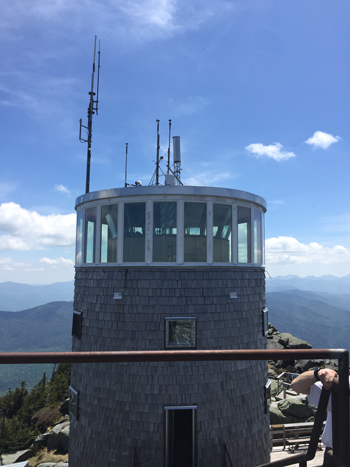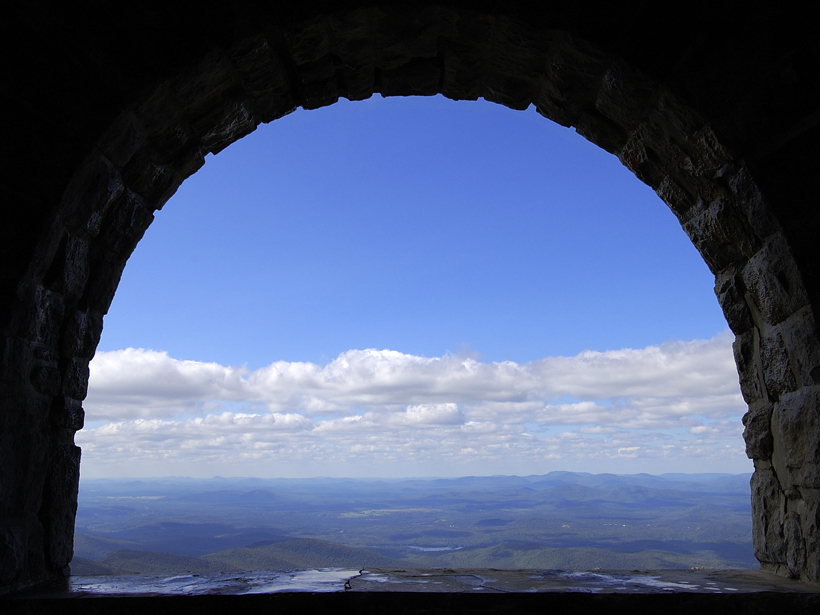Clouds cover 60% of Earth’s surface at any given time and are the primary means by which pollution gets lofted high into the atmosphere. They also are key to transforming soluble organic gases into particles once clouds evaporate. However, field campaigns and satellite retrievals typically avoid clouds, which hinders knowledge of how clouds affect tropospheric composition.
In September 2016, approximately 40 researchers, with expertise ranging from cloud chemistry modeling to cloud water sampling from mountaintops and aircraft, gathered for the Whiteface Mountain Cloud Chemistry Workshop. The workshop, held at the Marble Mountain Lodge near Wilmington, N.Y., brought cloud scientists together with the goal of designing a coordinated investigation of clouds and tropospheric composition in upstate New York.

Attendees reviewed past mountaintop cloud chemistry studies to learn about successful operations and needed improvements for mountaintop cloud studies. Among the reviewed studies, the researchers considered past atmospheric research at a field station run by the University of Albany. The field station, locally known as the Whiteface Mountain Summit Observatory, routinely collects cloud water samples. Marble Mountain Lodge also is a node of the National Atmospheric Deposition Program (NADP) and Clean Air Status and Trends Network (CASTNET) monitors.
Workshop participants also reviewed other field-based efforts for cloud research, such as the Great Dun Fell experiments in northern England, the Field Investigations of Budgets and Conversions of Particle Phase Organics in Tropospheric Cloud Processes (FEBUKO) in Germany, and the Hill Cap Cloud Thuringia 2010 (HCCT 2010) experiment, also in Germany.
For future field campaigns that capitalize on existing infrastructure like that at Whiteface Mountain’s field station, the workshop highlighted several goals:
- quantify the effects of clear-sky sampling bias in chemical characterization of the troposphere
- identify key oxidants driving aqueous phase chemistry through radiometric and chemical analysis, especially for organic compounds
- quantify how aerosol characteristics change by cloud processing
- identify tracers for cloud processing
- quantify entrainment and transport of chemical constituents into the free troposphere
- determine the importance of aqueous phase biological processes on aqueous chemistry
Given these objectives, workshop participants discussed the capabilities at Whiteface Mountain for conducting a cloud chemistry experiment and how such an experiment would be designed. Because the summit is cloudy 20% to 60% of the time from June to September, using hourly data, the researchers determined that Whiteface Mountain would be an excellent location to investigate chemistry in clouds.
Participants also discussed results from regional and zero-dimensional box model studies to learn what atmospheric composition to expect and how cloud chemistry could affect that composition.
The workshop concluded with the decision to begin examining how clouds process trace gases and aerosols at Whiteface Mountain Observatory.
The workshop concluded with the decision to begin examining how clouds process trace gases and aerosols at Whiteface Mountain Observatory. Workshop participants are currently coordinating an analysis of cloud water samples from a September 2016 cloud event, and researchers are characterizing Whiteface Mountain cloud types, cloud properties, and airflow patterns. A small-scale pilot study will be conducted to examine water-soluble organic carbon and inform future field-intensive design.
More information on the workshop can be found on the workshop’s website. The workshop was sponsored by the U.S. National Science Foundation.
—Annmarie Carlton (email: [email protected]; @amgcarlton), Department of Chemistry, University of California, Irvine; Mary Barth, National Center for Atmospheric Research, Boulder, Colo.; and Sara Lance, Atmospheric Sciences Research Center, University at Albany, State University of New York
Citation:
Carlton, A., M. Barth, and S. Lance (2017), Designing mountaintop cloud experiments, Eos, 98, https://doi.org/10.1029/2017EO072373. Published on 12 May 2017.
Text © 2017. The authors. CC BY 3.0
Except where otherwise noted, images are subject to copyright. Any reuse without express permission from the copyright owner is prohibited.

